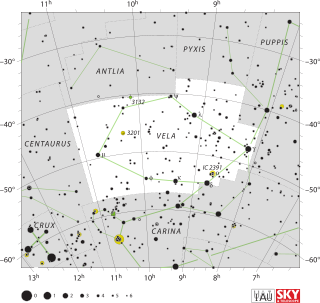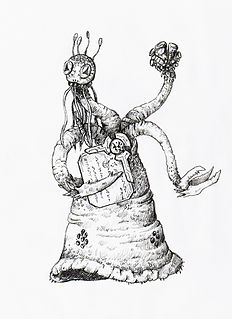This article is being considered for deletion in accordance with Wikipedia's deletion policy. Please share your thoughts on the matter at this article's entry on the Articles for deletion page. |

The following fictional celestial bodies figure prominently in the Cthulhu Mythos stories of H. P. Lovecraft and other writers. Many of these astronomical bodies have parallels in the real universe, but are often renamed in the mythos and given fictitious characteristics. In addition to the celestial places created by Lovecraft, the mythos draws from a number of other sources, including the works of August Derleth, Ramsey Campbell, Lin Carter, Brian Lumley, and Clark Ashton Smith.

An astronomical object or celestial object is a naturally occurring physical entity, association, or structure that exists in the observable universe. In astronomy, the terms object and body are often used interchangeably. However, an astronomical body or celestial body is a single, tightly bound, contiguous entity, while an astronomical or celestial object is a complex, less cohesively bound structure, which may consist of multiple bodies or even other objects with substructures.

The Cthulhu Mythos is a shared fictional universe, originating in the works of American horror writer H. P. Lovecraft. The term was coined by August Derleth, a contemporary correspondent and protégé of Lovecraft, to identify the settings, tropes, and lore that were employed by Lovecraft and his literary successors. The name Cthulhu derives from the central creature in Lovecraft's seminal short story, "The Call of Cthulhu", first published in the pulp magazine Weird Tales in 1928.

Howard Phillips Lovecraft was an American writer of weird fiction and horror fiction. Born in Providence, Rhode Island, he spent most of his life there, and his fiction was primarily set against a New England backdrop. Lovecraft was never able to support himself from earnings as an author and editor, and he subsisted in progressively strained circumstances in his last years. He died of cancer at the age of 46.
Contents
- A
- Abbith
- Aldebaran
- Algol
- Arcturus
- Argo Navis
- B
- Baalblo & Yifne
- Bel-Yarnak
- Betelgeuse
- Byldha
- Bzlah-ech'ya
- C
- Celaeno
- Coma Berenices
- Corona Borealis
- Cykranosh
- E
- Etx'ag
- F
- Fomalhaut
- G
- Glloesh-Vho
- Glyu-Uho
- Gnarr-Kthun
- G'nug-Tha
- G'yoth & Yg'giath
- H
- Haddath
- Hchab
- Hyades
- K
- K’gil’mnon
- Korvaz
- Kr’llyand
- Ktynga
- K'yi-Lih
- Kynarth
- Kythanil
- L
- L'gy'hx
- M
- Mirkalu
- Mthura
- N
- Nyil-yath Rho
- O
- Ogntlach
- P
- Pherkard
- Phphun
- Pleiades
- Pnidleethon
- Polaris
- Ptharg
- Q
- Q'in
- R
- Rhylkos
- Rigel
- S
- Sargas
- Shaggai
- Shonhi
- Shumath-Ghun
- Sigma Octantis
- Small Magellanic Cloud
- Syrgoth
- T
- Thuban
- Thuggon
- Thyoph
- Tindalos
- Tond
- Trifid Nebula
- U
- Urakhu
- V
- Vega
- Vhoorl
- Vix’ni-Aldru
- V'zath
- W
- Wezen
- World of Seven Suns
- Wu'unaya
- X
- Xandra
- Xecorra
- Xentilx
- Xiclotl
- Xithor
- Xoth
- Y
- Yaddith
- Yadoth
- Yaksh
- Yamil Zacra
- Yarnak
- Yekub
- Yilla
- Yith
- Yl'glhuh
- Ylidiomph
- Ymar
- Yuggoth
- Z
- Zaoth
- Zlykarlor
- Z'ylsm
- References
- Notes
- External links
- Wikisource links
- Other links
Overview:
- Name. The name of the celestial body appears first.
- Description. A brief description follows.
| Contents: | A B C F G H K L M O P R S T U V W X Y Z |
| References — Notes — External links |














